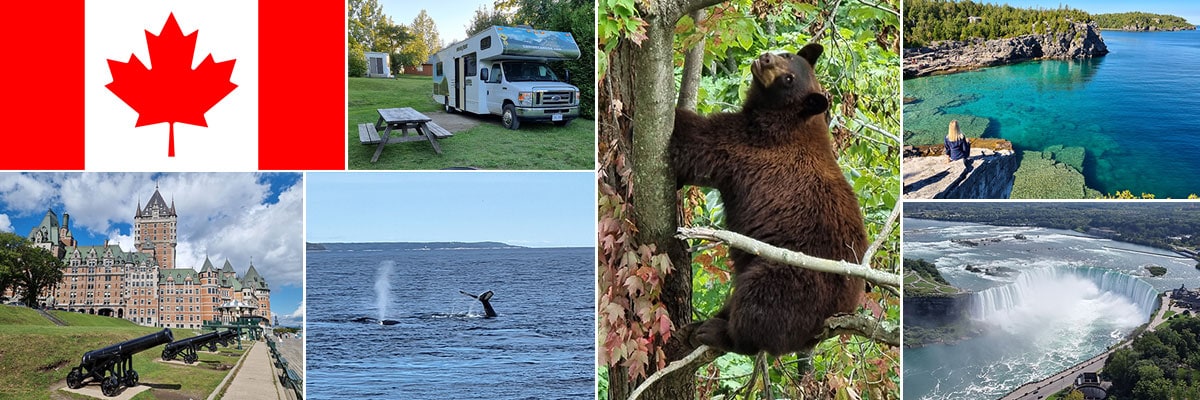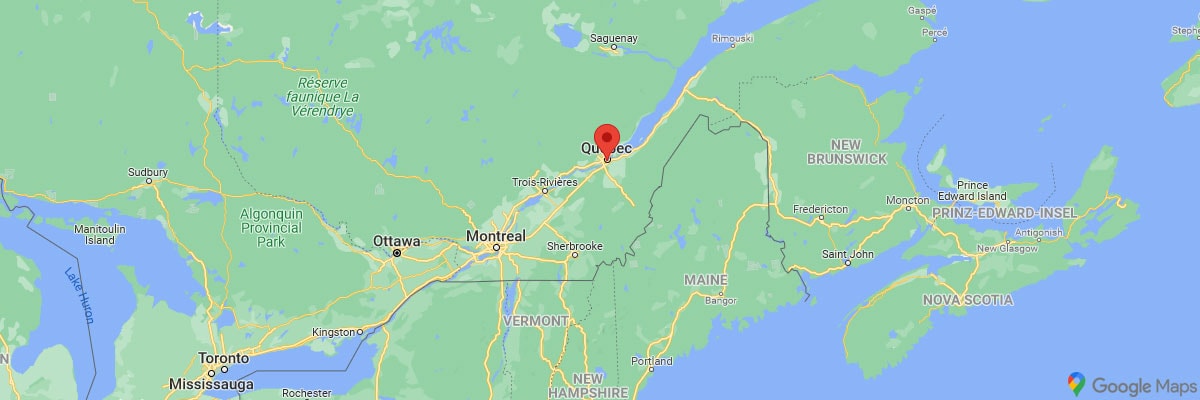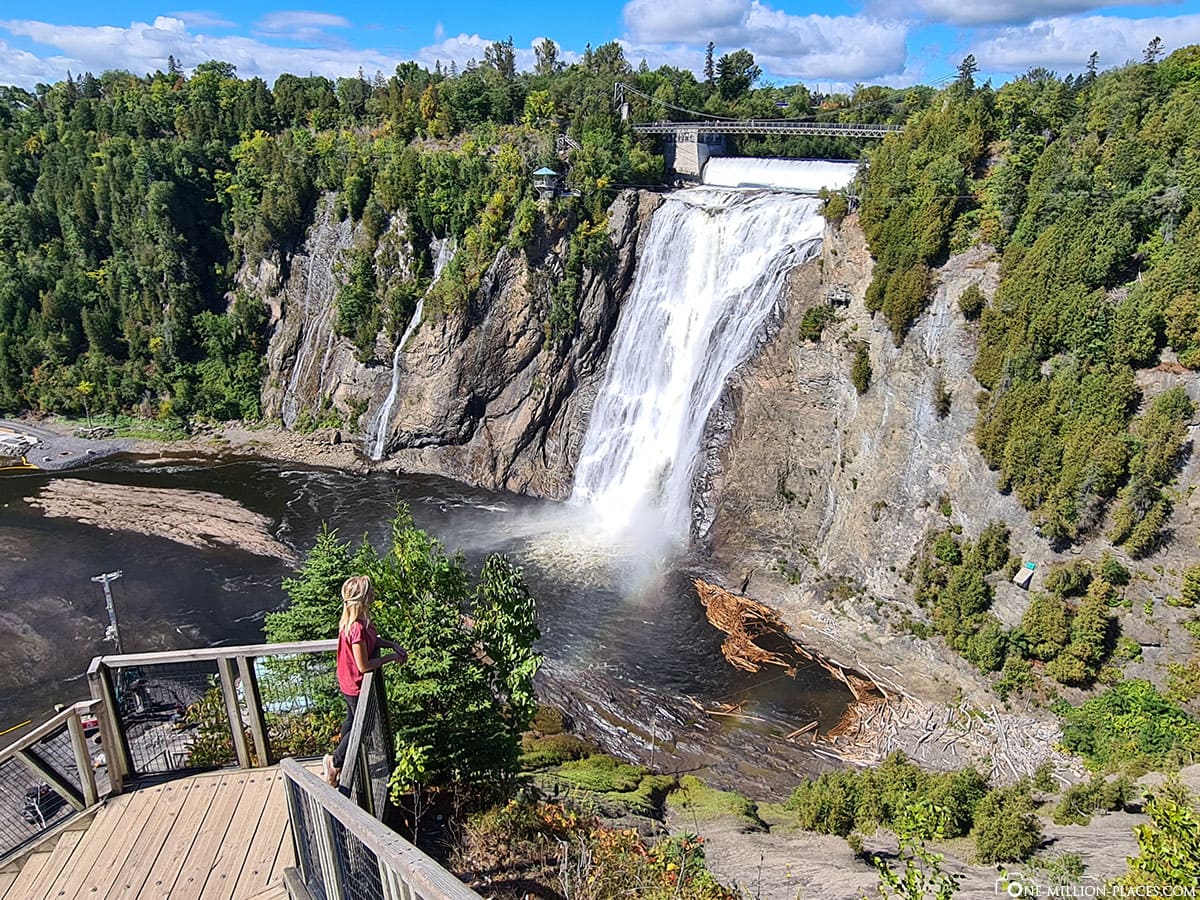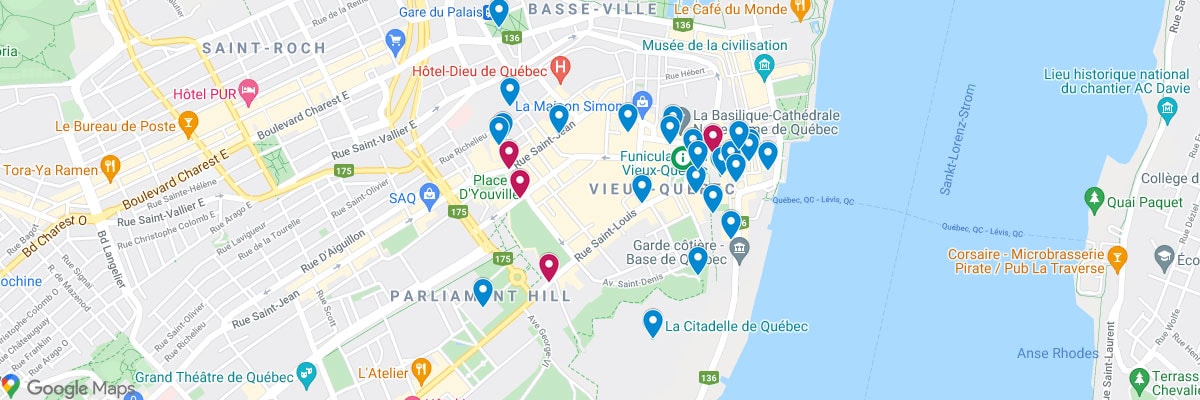Today we were going to explore Québec City – the capital of the province of the same name Québec. In the lovely city on the St. Lawrence River we were able to discover beautiful spots during our walk: including the star-shaped citadel, the stone buildings and narrow streets around the Place Royale, the cobblestone streets of the Petit Champlain district and the majestic Hotel Château Frontenac.

Table of contents
Our campsite “Coop Camping Saint-Esprit”
For the stay in Quebec City we booked for 2 nights at the campsite Coop Camping Saint-Esprit which is located about 17 kilometers north of the city center. The campsite is really huge and very well equipped: there are real paved streets, a large meeting room for 250 people, a heated pool, a brand new children’s playground, a tennis court, a library and very well functioning, free Wi-Fi network. When we drove over the campsite, we felt really small with our motorhome, because here were really big motorhome buses (especially from permanent campers) with everything Pipapo. Really crazy!
Our pitch was a full hook-up pitch with electricity, water & sewage. There was also a picnic bench and a fire bowl. You actually stand here very close to other campers, but that didn’t bother us. Since at this time it was already the end of the high season, many campers left on the second day, so that it became really quiet from then on.
Things to know about Quebec City
Quebec City is the capital of the province of Quebec and with its almost 540,000 inhabitants the eleventh largest city in Canada. Founded in 1608, the city on the north bank of the St. Lawrence River is now the only fortified city in North America. Due to its well-preserved old town it is also considered one of the oldest and most European cities in North America. In total, the old town covers an area of 135 hectares and counts around 1,400 buildings dating back to the 17th century. Since 1985, Quebec City’s Old Town and fortifications have been an UNESCO World Heritage Site.
Interestingly, about 94% of the population of Quebec City is French-speaking and French (along with English) is the official language throughout the province of Quebec. This is due to the bilingual history of the country. The discoverer of Canada is the Italian Giovanni Caboto, who landed under the English flag on a Canadian island in 1497 and took possession of the land for England. In the years 1534/35 the French also came to Canada, who founded Quebec, the first Canadian settlement. For a few years, the colonists lived peacefully side by side: the French lived in the area of the islands and the St. Lawrence River, the English further south on the American east coast (today’s USA). But later there were also conflicts here: France ultimately had to give up its colony in Canada to Great Britain. Thus, all of North America was British; the former French colony of New France became the province of Quebec.
Attractions & Photo Spots in Quebec City
From our campsite we drove in to Quebec City at 9 o’clock in the morning with an UBER for 27 CAD (19 EUR). In the city itself, we were able to explore all the sights on foot and on our own.
Parliament Hill
We started our city tour on Parliament Hill, the government district of the province of Quebec. Among other things, the Hôtel du Parlement du Quebec built between 1877 and 1886, is the seat of the National Assembly and the Lieutenant Governor of the Canadian province of Québec. Perched in the roundabout in front of the Parliament building is the Fontaine de Tourny fountain built in 1855 in the twin city of Bordeaux and brought to Quebec in 2007.
On the government hill is also the Édifice Marie-Guyart, built in 1972, which is the tallest building in the city at 132 meters. On the 31st floor there is the observation deck Observatoire de la Capitale, from which you have a great view of the entire city and the surrounding region. Unfortunately, the platform was closed due to the pandemic, so we could not visit it.
The city gates and city walls of Québec
Quebec City is the only fortified city in North America and therefore also has a city wall, which has been a National Historic Site since 1985 and is on the UNESCO World Heritage List. The approximately 4.5 kilometer long fortifications in the upper town are part of a defensive system that was built between 1608 and 1871.
Over the decades, the city wall initially fell into disrepair. But in the middle of the 19th century the facilities were strengthened and expanded. Parts of this city wall can still be walked on today. Also worth seeing are the four city gates with their defensive towers, which were also rebuilt and restored: The Porte Saint-Jean, the Porte Saint-Louis, the Porte Prescott and the City Gate Porte Kent.
The shopping street Rue Saint-Jean
From Saint Jean’s city gate runs the traffic-calmed shopping street Rue Saint-Jeanwhich is one of Québec City’s oldest shopping streets. In the 19th century, numerous merchants settled there in houses that simultaneously served as business premises and gave the street its special charm. Even today, the street is very lively and popular due to the many shops, restaurants and street musicians.
The Church of Notre-Dame de Québec
In the old town is the somewhat inconspicuous cathedral basilica of Notre-Dame de Québec which was built from 1923 to 1930 and is the seat of the Roman Catholic Archdiocese of Québec. The first church building on this site dates back to 1647, but unfortunately has been destroyed over the centuries. A new building built later burned down in the winter of 1922. Due to its architectural value, the basilica has been declared a national historical site and is a listed building.
The Fairmont Le Château Frontenac
We were particularly impressed by the Château Frontenac in the heart of the city, which is one of the main attractions of Quebec City. At first glance, it looks like a castle, but is actually a luxury hotel of the Fairmont hotel chain. The hotel was built in 1893 for the Canadian Pacific Railway in the style of historicism and today offers 610 luxurious guest rooms and suites. Over time, the hotel, which has been designated a national historic site since 1981, has been expanded three times and awaits its visitors with a “touch of old Europe”. In addition, the hotel holds the Guinness World Record for the “most photographed hotel in the world”.
If you want to stay in the famous hotel, you can book a room with Booking.com from 180 EUR per night.
The Dufferin Terrace
At the Hotel Château Frontenac runs the 430-meter-long Dufferin Terrace from which you have a fantastic view of the luxury hotel and the St. Lawrence River 80 meters below. The viewing terrace was built in the 1870s and leads from the citadel to near the Place d’Armes. On the site of today’s Dufferin Terrace was once the Château Saint-Louis, built in 1648, which served as the governor’s seat and at that time had a small viewing terrace in front of it for visitors. Unfortunately, Château Saint-Louis burned down completely in 1834, the ruins were removed and the publicly accessible Durham viewing terrace was created. The then Governor-General Lord Dufferin proposed to beautify the cityscape to significantly extend the Durham Terrace and thus make it an attraction. The Dufferin Terrace was created. Today, the terrace is visited by about 2 million people a year, making it one of the most popular attractions in the city. By the way, the remains of Château Saint-Louis can be visited for 3.90 CAD (2.80 EUR) in the “Saint-Louis Forts and Châteaux National Historic Site”, whose access is on the Dufferin terrace.
At the northern end of the Dufferin Terrace is the hill station of Quebec’s funicular. The Funiculaire du Vieux-Québec connects the upper town on the rocky spur Cap Diamant with the lower town over a length of 64 meters. We did not use them, but walked down the “breakwater stairs” into the lower town.
The Petit Champlain district
Via the oldest staircase of Quebec City, the Escalier Casse-Cou (“Breakbreaker Staircase”) built in 1635, we walked from the upper town to the lower town. In the cobblestone streets of the Petit Champlain district, there are many restaurants, cafes and boutiques. A particularly beautiful photo motif are the many umbrellas in the Rue du Cul-de-Sac.
Particularly worth seeing is the 100 m² mural at house number 102 on Rue du Petit-Champlain. It depicts the history of the neighborhood, the bombings of 1759, the landslides and the fires that occurred in this neighborhood.
Around the Place Royale
A few meters away is the Place Royale where the French navigator Samuel de Champlain founded a trading post on July 3, 1608, from which the later city of Quebec City developed. We really liked the beautiful stone buildings and the narrow streets around the Place Royale. In the most beautiful September weather, the cafés and restaurants were well filled and numerous visitors strolled through the square. A highlight on the Place Royale is the small Roman Catholic church of Notre-Dame-des-Victoires. Built in 1688, it is considered the oldest stone church in North America.
A stone’s throw from the Place Royale, we discovered a huge mural. Inaugurated in 1999, the “Fresque des Québécois” on Rue Notre-Dame covers a complete wall of the house with a size of 420 m² and tells the 400-year history of Québec City. Totally impressive!
The Citadel
In the afternoon we visited the citadel of Quebec City, a star-shaped fortress. The citadel was built between 1820 and 1850 and is the largest British fortress built in North America. After the Anglo-American War, the citadel was in order to prevent the Americans from crossing the St. Lawrence River and thus reaching Canada. In all these years, however, the fortress was never attacked. Part of the fortress has served as barracks for the 22nd Royal Regiment of the Canadian Army (“Royal 22e Régiment”) since 1920. It is also home to the governor-general of Canada.
The citadel can only be visited as part of a one-hour guided tour for 18 CAD per person (13 EUR), so we spontaneously joined the next English-speaking tour. With our guide and about 10 other people, we visited various points in the outdoor area and finished the tour on the wall of the citadel. We would have hoped for a little more insight into the citadel, nevertheless the tour was interesting. The entrance fee also includes a visit to the museum, which we skipped due to time constraints.
More Sights & Photo spots
On our walk through Quebec City we were able to discover many more beautiful buildings, sights and photo spots, such as the Hôtel de Ville. Inaugurated in 1896, city hall is the seat of Quebec City’s city government and we really liked it visually.
On the Place d’Armes runs the small side street Rue du Trésor where local artists exhibit and offer for sale their watercolours, engravings, paintings and reproductions. As a rule, the artists are here daily from mid-May to mid-October. Throughout the rest of the year, some artists are present on holidays and weekends when larger crowds are expected in the Old Town.
On a corner in the old town we discovered a pretty white and red house: the Maison François-Jacquet-Dit-Langevin. It was built in 1677, making it one of the oldest residential buildings in all of Québec. Since it has remained relatively untouched over the centuries, it is a very good example of residential architecture during the French regime.
We also got to know Quebec in culinary terms: For lunch, we tried the Canadian fast food specialty poutine which consists of chips, curd and gravy and was probably invented in rural Quebec in the mid-1950s. Today, this dish is popular throughout Canada and is also used, for example. offered at McDonald’s and Burger King. The composition of the ingredients sounds a bit strange at first, it also looks somehow strange, but actually tastes good.
One of our highlights at the end of our sightseeing program in Quebec City was the visit to the Parc du Bastion-de-la-Reine. Because from the “La Terrasse Saint-Denis” you have a fantastic view of the old town of Quebec and the St. Lawrence River.
The Montmorency Waterfall
About 15 minutes from downtown, lie the impressive Montmorency Falls. After paying the entrance and parking fee of 20 CAD (14 EUR), we were able to park our motorhome comfortably in the associated parking lot and walk from there towards the waterfall. First we walked over the suspension bridge that leads above the waterfall. Standing at the point where the waterfall flows down the cliff with a roaring sound was really impressive.
From a vantage point opposite the Montmorency waterfall, we could see very well how it plunges over a rock face 83 meters deep into the St. Lawrence River. This makes it the highest waterfall in the province of Quebec and about 30 meters higher than the famous Niagara Falls.
Québec, we really liked you! ❤
A map of Quebec City’s attractions & photo spots
On the following map at Google MyMaps we have marked the most famous sights and most beautiful photo spots of Quebec City in Canada. If an important point is missing from the map, just write it to us in the comments below. We are happy to add this point to the map.
All travel reports from our camper round trip through Canada
Vacation with the camper or motor home in Canada - for many probably quite normal, but for us it was actually the first time. We have never been on the road with a camper, but always wanted to try it. In total, we drove almost 3,300 kilometers with our camper and explored beautiful regions and cities in eastern Canada. » Our Holiday in Canada 2021 - Flight, Entry & Itinerary
» Our Holiday in Canada 2021 - Flight, Entry & Itinerary» Camping in Canada - Our Questions, Experiences & Tips
» La Mauricie National Park - A hike on the Les Cascades Trail
» Québec City - Things to do, Sights & Photo Spots
» Canyon Sainte-Anne - Waterfalls, Cascades & Suspension Bridges
» Tadoussac - Whale watching on the Saint Lawrence River
» Parc Omega - Drive-Through Safari in Quebec
» Ottawa - The capital city of Canada
» Algonquin Provincial Park - Lakes, forests and magnificent viewpoints
» Bruce Peninsula National Park - Dreamlike bays at Lake Huron
» Niagara Falls - The largest waterfalls in North America
» Toronto - Things to do, Sights & Photo Spots
» Thousand-Islands National Park - 1.864 Islands in the Saint Lawrence River
» Montreal - Things to do, Sights & Photo Spots



